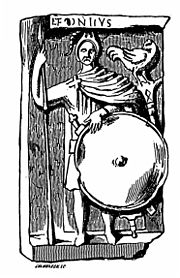
This page created 14 April 2014, and last modified: 5 October (some links added)

The Octavani is listed as one of the legiones palatinae in the Magister Peditum's infantry roster; it is assigned to his Italian command. Its shield pattern as shown in various manuscripts is as below:

Given its name, the Octavani is evidently (part of) the old Legio VIII Augusta Pia Fidelis Constans, dating back to Julius Caesar's day, and formerly based as Argentoratum (modern Strasbourg). Judging by an inscription (CIL 13.11538) mentioning (at least part of) the legion at Etzgen in northern Switzerland dating to 371 AD, it had apparently been partially or entirely moved away from Strasbourg before being drafted into the Magister Peditum's Italian command; the legion is also know to have contributed a detachment to garrison Divitia on the east bank of the Rhine across from Colonia Augusta (Cologne) in the 4th century. Note that there is a frontpiece illustrating Comes Argentoratensis in the Notitia, but the command appears to have been rendered defunct at some point, as he is not listed as controlling any troops, towns, or officers.
The position of the Octavani in the Italian list would indicate that it was a comitatenses unit when the Notitia was first drawn up (since it is positioned well down the list, in the usual position for comitatenses units), but later promoted to the palatine status it is recorded as having in the Magister Peditum's infantry roster. Half of the 12 palatine legions in the western empire are such "recently" upgraded units. The upgrading could not have been all that recent however, since its shield pattern is positioned with the other palatine legions, and not the comitatenses units. This is enough to give one serious pause with regard to dating units based on where they appear in various lists, because it would be normal to expect simple textual entries to be modified before elaborate illustrations.
The shield pattern is very similar to that of the Vesontes, a legio comitatenses assigned to the "Comes" Hispenias. A comparison, using the patterns given in the Parisian manuscript, makes this obvious:

Perhaps a unit from Vesontio (modern Besancon in France) was brigaded with a detachment of the Eighth legion at some point in the 4th century, or perhaps it was a detachment of the Eight itself that was stationed there and became the Vesontes. If someone could fill me in on the Roman military history of Besancon, I'd be grateful!
The morel-shaped emblems that make up the shield pattern bring to mind the business end of a military "turf cutter" (the Latin word for which is unknown, and which re-enactors suspect was used for some other job, because it does a poor job of cutting turf); the photo below shows one excavated from Newstead in Scotland:

Taken from this book published in 1911, and now in the public domain.
They are also reminiscent of a shield borne by one of the soldiers on the 4th century Brescia Casket, as shown below:

Photo by RobyBS89, and dedicated to the public domain.
Below is the gravestone of Lepontius, who appears to have been a member of the Legio VIII in the 4th century, and which was found in Strasbourg in 1737 (and destroyed in World War 2; what is now displayed in the archaeological museum in Strasbourg is a copy). No shield pattern is indicated, but the fact he has a round shield, as opposed to oval, is interesting.


Return to the Notitia alphabetical unit list page.
Return to my Notitia index page.